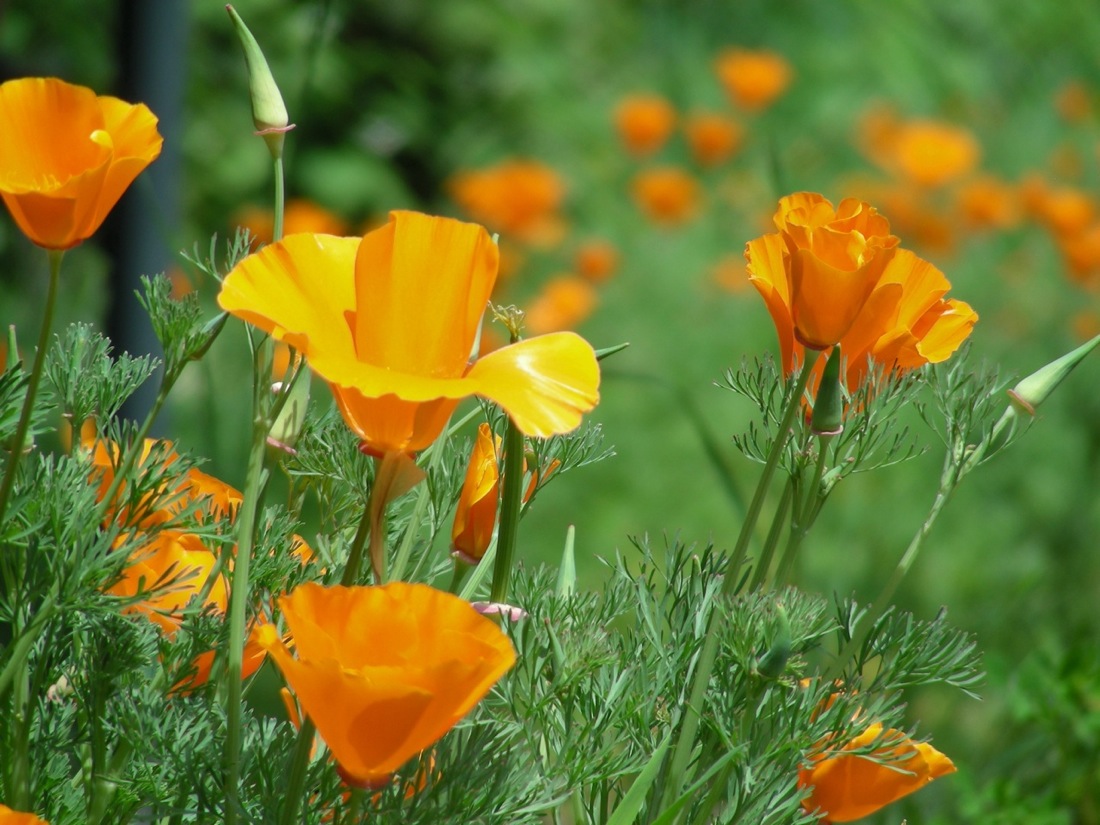
Photo/Illustration: Billy Goodnick
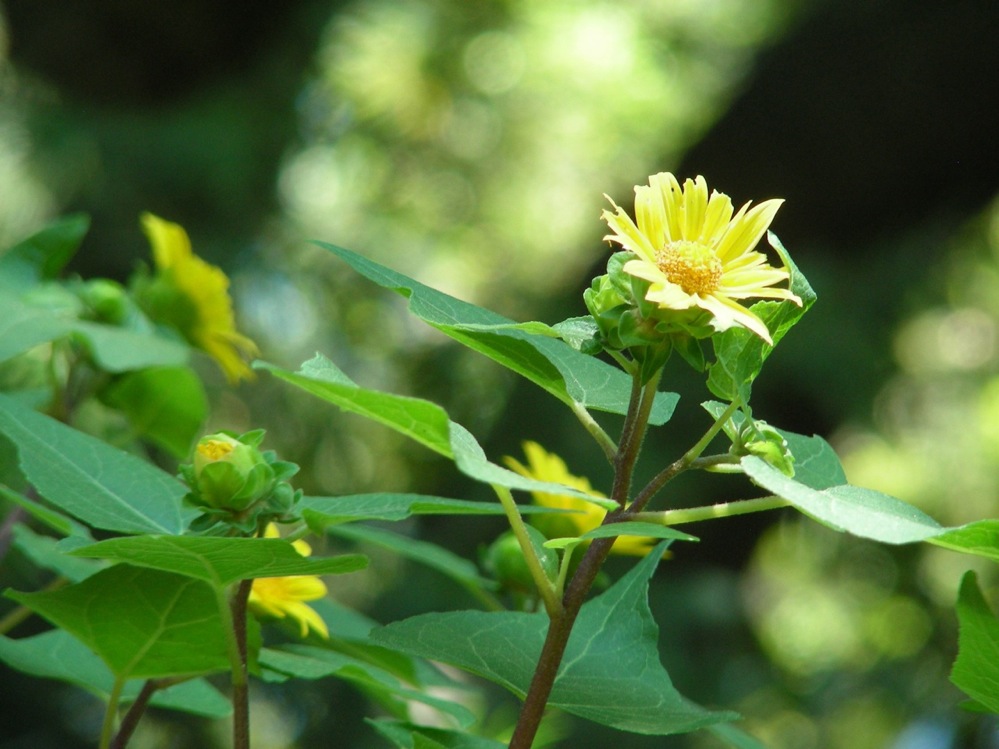
Photo/Illustration: Billy Goodnick

Photo/Illustration: Billy Goodnick
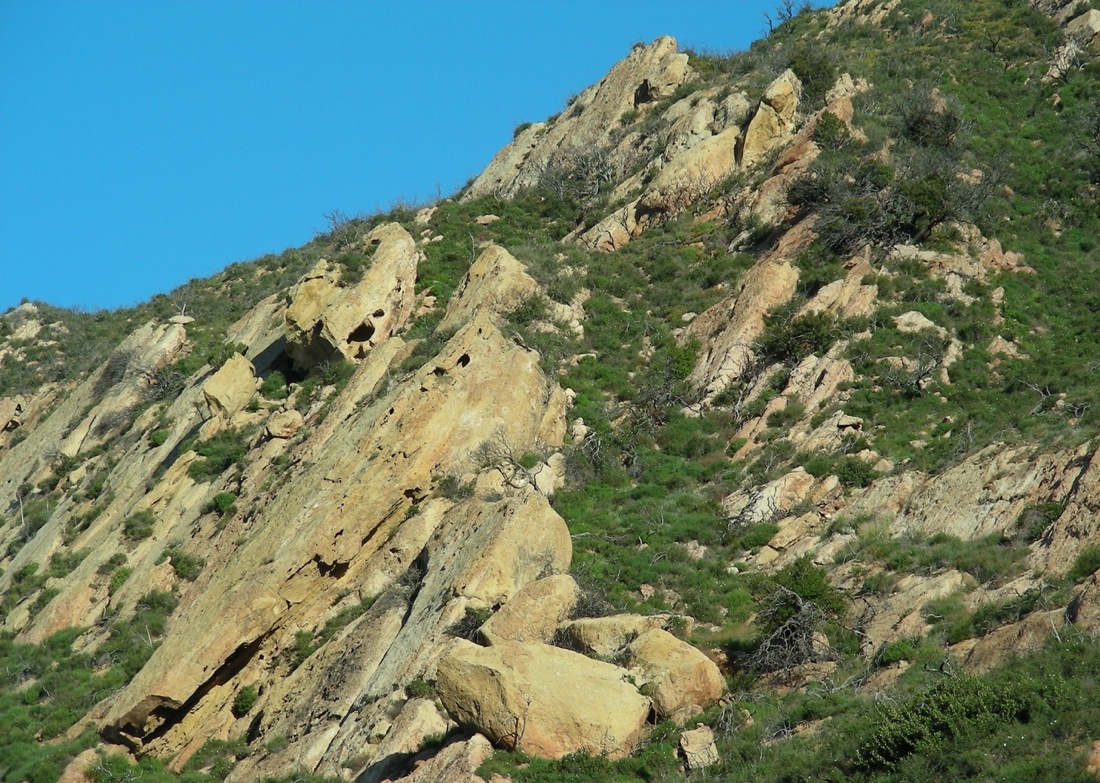

Photo/Illustration: Billy Goodnick

Photo/Illustration: Billy Goodnick

Photo/Illustration: Billy Goodnick

A commanding, metallic voice crackles over the bullhorn. “Step back from the rototiller, get down on your knees, clasp you hands behind your head.”
As the terra-terrorist haltingly complies, a team of darkly clad commandos inches forward on their bellies. Suddenly, with blinding speed, the well-rehearsed ensemble kills the engine of the growling, grinding metal monster and swiftly ushers the gardener into a waiting unmarked van. Their destination, the CGGRC (Cool Green Gardening Re-education Center).

|
| California poppies (Eschscholzia californica) are exquisite, self-sowing annuals found from Mexico to Oregon. |
Scenarios like this fire across my synapses more often than I’d care to admit. That’s because I have a strong emotional response when I see people ignoring one of the most basic tenets of sustainable landscaping: Work with, not against, what nature gives you.
That includes your soil.
My most recent “trigger” was an article in a local newspaper instructing reader about creating “your perfect paradise garden.” The writer used the usual “10 tips” approach, including “How to help your soil.” Readers were told to dump bags and bags of store-bought soil amendment into their beds to create a rich medium for their plants. “That way,” the writer enticed, “you can grow anything your heart desires.”
“Even if it means you have to put the plant on life support,” I thought.
Here’s my philosophy. How about designing with nature rather than working against it?
A Lesson From Nature
Living here in Santa Barbara, California, I look out at the Santa Ynez Mountains every day. Acres and acres of native chaparral vegetation burst with shades of blue Ceanothus flowers and entice with the rusty trunks of Manzanita.
 |
| I’ll never tire of the golden sandstone formations and rugged chaparral that hug the Santa Barbara coast. |
Shimmering golden California poppies dot the hillside in spring. Canyon sunflower brightens the dappled shade along the arroyos.
Nature does this with no help from me or anyone else, thank you very much. No one turns on the sprinklers, spreads fertilizer or amends the soil. No weekly gardener, no “projects” that consume your three-day weekends.
Here’s my philosophy about adding all that organic material to your soil: Go with the flow. Why pay good money to add stuff to the soil, then rototill until the natural, living community of unseen flora and fauna is churned into oblivion?
It’s Alive!
 |
|
The delicate canyon sunflower (Venegasia carpesioides) thrives |
Many gardeners are unaware of the billions of living organisms that inhabit a handful of soil. An interconnected web of life. An ecology we cannot see.
Instead of trying to change your soil, select plants native to your area. If these don’t give you the aesthetic palette you seek, draw from areas in the world similar to yours. It stands to reason that there’s somewhere in Europe or Asia or South America with a climate and soil conditions just like yours. It also stands to reason that plants from those regions will thrive in the same conditions as the ones you already have.
 |
| Sometimes called mountain lilac, the Ceanothus species as a signature plant in the mountains and seaside cliffs of much of California. |
In my coastal southern California climate, I design gardens using plants from Chile, southwest Australia, South Africa, Italy, France, Spain, Libya, and my home state. They’re all adapted to my Mediterranean climate—dry summers, wet winters and moderate temperatures. Most need little or no fertilizer, can get by with minimal summer irrigation, and if I provide enough diversity, no pests.
I work with what nature gives me and let the fittest survive. My clients are overjoyed.
Best of all, this approach helps me avoid a run in with those commandos holed up in my frontal lobe.


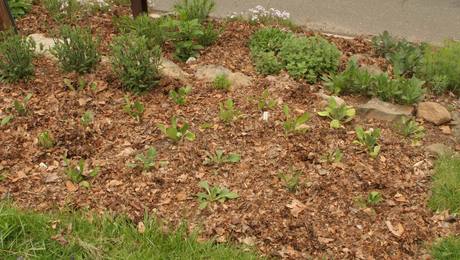
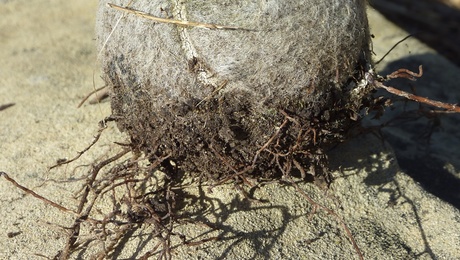
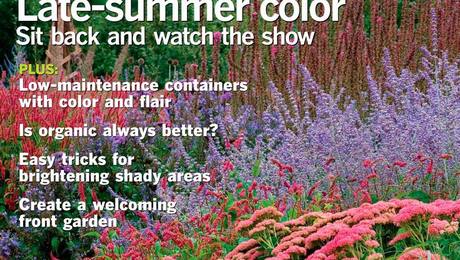












Comments
Amen to THAT, Billy! In general, I think people tend to make things harder than they have to be - gardens, included. I'm so glad to see gardeners like yourself educating folks about the importance of working WITH nature and not against it. After all, Mother Nature always wins. ALWAYS.
This comes at an opportune time... I'm lucky enough to live in a place with deep, rich, black soil that can support just about anything (making it through a Chicago winter is another story).
But if I'm starting with a plot of land that currently produces crabgrass like there's no tomorrow, isn't tilling (or, more likely, assault and battery with a cultivating fork) better than, say, chemical options to prep the space?
LpAngelRob: Mincing, dicing and tilling the grass will only spread rhizomes and seed, making next spring a nightmare. My suggestion is sheet mulching. There's a lot of info on the web if you do a quick search. It alleviates the need for sprays, increases the health of the soil and is a great way to kill off most grasses. You might also want to pick up a copy of Sustainable Landscaping for Dummies, but Owen Dell. Great info on the topic.
Good luck!
Thanks for this post! Great that you want to go with the flow. I appreciate your passion for gardening. http://bit.ly/rUEcM will give some tips on good landscaping!
Hey there, great article! I know you're from a different part of the country, but I was wondering what your thoughts would be on gardening in the gray clay soil that's found in parts of the Plains states (S. Dakota to be exact). We've (FINALLY!) moved into the country, and I would love to have a garden next year, but when my hubby and I were digging a spot to put some rhubarb I got from a friend, we got about 3 inches down and hit cement=clay. How would we grow root veggies in that?? Thanks for any insight you might have!
NancyDB: Hey, thanks for taking the time to leave a comment. I can only give you generalized info for two reasons: I'm not familiar enough with your area (actually, not AT ALL familiar) and, I don't know a lot about vegetable gardening. As a "full disclosure" read my first ever column here at Fine Gardening. It'll show you that The Emperor in only partially clothed. I'm a landscape architect who's career has focused primarily on design and teaching and I actually don't spend a lot of time digging in the dirt.
That said, the best, though gradual, method of improving any soil is the gradual addition of organic matter (not by rototilling). But breaking up, ripping or turning over the soil (more like plowing than CuisineArt) will help to incorporate the material a bit faster.
You might also start with some raised beds, as that gives you virtually complete control of the rooting medium, though at a bit more expense.
Your best bet is to fine a local garden coach (search for Garden Coach Directory - they have a listing by states) or check with a master gardener or possibly a University extension program.
Hope this gets you started. Y'all come back (I'm originally from the suthin' part of East Flatbush, Brooklyn, hence my accent =0)
Will do! Thanks for writing back!
Love your gardening philosophy. It seems to be similar to the one expressed in a saying I've always liked: "Don't fight the site."
That being said, often gardeners are dealing with properties that no longer have their original soils. Sometimes all they've been left with is the clay layer that used to be underneath a layer of topsoil. The only plants that will grow well on a site like that tend to be extremely hardy ones with long, powerful taproots. Although you might be able to find a native plant that would fit that description, most people find that such sites are quickly colonized by invasive non-natives such as dandelions.
As you point out, sheet mulching is a relatively easy way to amend clay soil and kill at least some weeds, including lawn grass. (In my experience, sheet mulching is great for killing grass and improving damaged soils but doesn't kill the tougher weeds, which can pop right through.) There's also a variation on sheet mulching, sometimes called "lasagna gardening," in which you pile the layers of mulch high enough to create a mounded bed. Being a deeper mulch, this is more effective at killing weeds, and it allows you to plant deep-rooted plants and plants that require good drainage, even on highly degraded sites.
I so agree Billy.
I spent a huge amount of store bought soil, to try and "grow what ever I wanted" in the soil of Las Vegas. Yeah, didn't work. I studied all winter so I could make a garden of what grows naturally, and what a pleasure it was! Working with Mama Nature is so much better and more pleasing to the eye!
What is a new gardener to think of your headline? It's correct where you are and mostly incorrect where I am, metro Atlanta. Why? Builders scraped away top layers of soil for construction leaving behind acidic non-percolating brick-like orange clay without natural bacteria, fungi, insects, etc. Mother Nature did not intend the plants of this region to grow in it.
Sure, you can have pine, sweetgum, oak and wait for Mother Nature's cycle to renew, in a few decades.
The reality? Amend soil with a 2" layer granite grit or river sand tilled 8"-10" deep. Amend soil with organic material? Why? It depletes within 2 years and you're back where you started.
Garden & Be Well, XO Tara Dillard
Great advice! I have another tip to offer. After getting a muscle disorder last year, I had to learn adaptions to my gardening. I think I have finally gotten the art of raised beds and container gardening which is also great for limiting weeding/tilling. I have also learned that it is possible to grow smaller trees in containers. It takes more for shade but it is do-able. Thanks for sharing your expertise.
I would like to encourage any 'soil builders' out there to be sure to check the Ph of you 'newly prepared' beds. Future amendments can be adjusted after that. Also, do not smother your newly planted plants by crowding their stems and crowns with mulch. I've lost several plants by doing that! As you are waiting for your new beds to 'ripen' a lot of pleasure can be had with containers. :0)
I liked your article and I envy those that live in parts of the good ol USA where you can grow beautiful & healthy plants. Not so for the Roanoke area of southwest Virginia! We have 0-1 inches of humus, 1 foot of red compacted clay, and couple inches of dark clay and 4-6 inches (or more) of shale. Around here you need garden islands, container gardens, or work the clay with leaf mold and compost. Working the clay takes several years to see the clay turn into good dirt for gardening. If one likes to grow weeds then mother nature is on your side around these parts of the Blue Ridge.
I've learned this is the best way to go over the years as well. Our natural woodland plants grow well in our woodland setting and look so much better than suffering plantings that crave full sun and such.
Unfortunately, near the house there is still a lot of sand I assume from the construction of the property. Nothing grows well at all and I am clueless how to amend it without digging out all the sand (and not dump more dirt on top, the erosion with our sparse plantings is bad enough)
Hey Billy, good to see your smiling face in yet another venue. Good on ya!
I have a real question. I use sheet mulching and it works very well, thank you! I also want that cool meadow look with wild flowers. I might be getting there, but sheet mulching doesn't seem like it would work. I have lots of the old bromus diandrus (rip gut) and black mustard that wants to lord over the whole area and keeps my poppies etc. from getting their fair share. Pulling them up is a pain in the gizard and sheet mulching would shut out my broadcast and natural seeding efforts as well as the brome. Any body out there got ideas.
Santa Barbara chaparral resident
Garden Paddler: Big thumbs up for your effort! Good to see you taking your garden toward a more naturalistic system.
As for sheet mulching, it should eventually do the job to break the cycle of weeds you currently battle. But when the battle's done and all the corpses of your fallen enemies are vanquished, you're probably correct about getting seeds started, due to all the "fluff" and cardboard remnants left at the surface from the mulch. You might have to actually do a little tilling (doesn't have to be an indiscriminate gas-powered tiller if the area is manageable by hand) to get enough organic, mineral soil back to the surface. Just don't go overboard. If you start smelling magma, shift to low gear.
Hope this helps. Also, check out John Greenlee's American Meadow Garden book for ideas on getting a full-fledged, diverse meadow started. I'll be doing a review of his book in the coming weeks. Look for it at Timber Press.
Log in or create an account to post a comment.
Sign up Log in